The Graduate Nursing Project collection includes Doctor of Nursing Practice (DNP) Scholarly Projects and Master's students' non-thesis projects submitted as part of program requirements.
TO
Filters: Type: "Text" Collection: ehsl_gradnu
| Title | Creator | Date | Description | ||
|---|---|---|---|---|---|
| 76 |
 |
Implementation of the VExUS Protocol: A Quality Improvement Project | Barco, Samuel; Drury, Zach; Favero, Heidi; Gee, Julie | 2023 | Background: Renal disease remains a significant problem in the United States, where 37 million people live with chronic kidney disease (CKD) and 786,000 live with end-stage renal disease (ESRD). Accurate fluid status assessment is essential to caring for these patients. Local Problem: The University... |
| 77 |
 |
Implementing A Postoperative Extubation Protocol | Steinfels, Brittany; Alderden, Jenny | 2022 | Background: Timely extubation is vital for Cardiovascular Intensive Care Unit (CVICU) patients who undergo coronary artery bypass graft (CABG) surgery because longer durations of time spent intubated are associated with risk for mortality, delirium, and longer length of stay in the ICU. The Society ... |
| 78 |
 |
Implementing an Intubation Guideline in the Intensive Care Unit | Patterson, Scott W.; Jarvis, Matthew W. | 2022 | Background: Intubation, even when done properly, can have negative consequences. Roughly 6% of patients intubated in the emergency department acquire hypoxia as a result intubation, or while intubated (Brown, 2021). "Endotracheal intubation in the intensive care unit (ICU) carries with it a higher m... |
| 79 |
 |
Improving Clinicians' Experience of End-of-Life Care in the Intensive Care Unit Through Implementation of the ‘3 Wishes Project' | Nelson, Kendall K. | 2023 | Background: The '3 Wishes Project,' is an end-of-life program meant to bring humanity and dignity to dying patients, while encouraging meaningful connection and multidisciplinary communication among clinicians. The purpose of this project was to improve clinician experience of end-of-life care in th... |
| 80 |
 |
Improving Diagnosis and Management of Non-Alcoholic Fatty Liver Disease in the Primary Care Setting | Cosentino, Jenifer A.; Lynch, Keisa | 2022 | Background: Non-alcoholic fatty liver disease (NAFLD) in the United States continues to increase with the rise in obesity and type 2 diabetes. The prevalence of NAFLD in 2015 was 83.1 million. The prevalence of this disease is expected to increase to 100.9 million by 2030. Provider knowledge gaps re... |
| 81 |
 |
Improving Patency of Feeding Tubes by Implementing a New Clinical Practice Guideline: A Quality Improvement Project | Bates, Brittany E.; Lynch, Keisa | 2022 | Background: Patients with feeding tubes are at risk of experiencing internal obstructions caused by clotting of intact protein formulas, crushed medications, refluxed gastric contents, and viscous products that enter the tube. A variety of anecdotal methods for attempting to unclog feeding tubes inc... |
| 82 |
 |
Improving Pre-Arrest and Cardiac Arrest Performance in an Acute Care Setting | Campbell, Sarah; Alderden, Jenny | 2023 | Background: Cardio-pulmonary resuscitation (CPR) and other emergent resuscitation practices in hospitals are lifesaving. Delayed or poor-quality CPR and resuscitation leads to increased mortality and poor neurologic function. Local Problem: Ogden Regional Medical Center (ORMC) has been identified as... |
| 83 |
 |
Improving Self-Efficacy and Teamwork in Moderate Acuity Clinical Situations | Miller, Devon M,; Jarvis, Matthew W. | 2022 | Background: Practice tools and training are essential to building staff confidence, competency, teamwork, perceived self-efficacy, and by extension, they improve clinical outcomes. For new providers in many hospital settings, there is an emphasis on training in Advanced Cardiac Life Support (ACLS) a... |
| 84 |
 |
Improving Skin Assessments in Darkly Pigmented Skin and Incontinence-Associated Dermatitis in the Acute Care Setting: A Quality Improvement Project | Ly, Tracey; Bytendorp; Kylie; Doyon, Katherine | 2023 | Background: Detecting erythema and compromised skin integrity is challenging in darkly pigmented skin. Current literature states skin assessment and treatment education are tailored toward white patients. It is vital nurses are trained to identify breakdown and treat compromised skin integrity in al... |
| 85 |
 |
Improving the Ability of Novice Advanced Practice Clinicians and Students to Recognize Clinical Deterioration and a Need for Transferring Care | Varner, Sarah; Christensen, Scott | 2022 | Background: Early identification of clinical deterioration and quickly transferring to a higher level of care are essential for decreasing in-hospital mortality and improving patient outcomes. Although there are support tools and guidelines to help recognize clinical deterioration, a gap remains as ... |
| 86 |
 |
Improving the Quality of Sleep in Patients on an Acute Medicine Unit Using a Sleep Hygiene Bundle | Lang, Tanisha E.; Whitt, Alex; Lynch, Keisa M. | 2023 | Abstract Background: Poor sleep is common in ICU and acute ward settings due to noise and other factors, negatively impacting patients' cognitive function and quality of life. Neglecting healthy sleep practices in hospitals can have adverse implications for patient outcomes because of the restorativ... |
| 87 |
 |
Increasing Remote Patient Monitoring Usage Among Heart Failure Patients via a New Clinic Protocol: A Quality Improvement Project | Tonks, Trevor K.; Ugolini, Sharon; Gee, Julie P. | 2022 | Background: Heart failure effects six million adults in the United States and the prevalence is expected to increase 46% from 2012 to 2030. The advancement of technology has provided significant improvements to our disease management of heart failure, specifically, the use of remote patient monitori... |
| 88 |
 |
Patient Teaching about Naloxone in the Emergency Department: The Creation and Implementation of a Clinical Practice Guideline | Barney, Heather Ann; Christensen, Scott S. | 2022 | Background: Opioid overdose is the leading cause of preventable death in the Utah, and nationally. Utah ranks seventh in the nation for opioid overdose deaths with eight deaths weekly. Fatalities have continued to rise dramatically for over thirty years. Intensified by the COVID-19 pandemic, the Cen... |
| 89 |
 |
Proficiency of EKG Interpretation in the Primary Care Setting: A Quality Improvement Initiative | Perry, Rachelle C. | 2023 | Background: The American Heart Association (AHA) reports that heart disease is the leading cause of death for men, women, and people of most racial and ethnic groups in the United States, costing nearly $1 billion daily. An estimated 80% of these cases are preventable; almost 400,000 people in the U... |
| 90 |
 |
Trauma and Critical Care Team Skills Program: A Program Evaluation | Lang, Jesse L.; Ward, Denise; Doyon, Katherine | 2023 | Background: Advanced Practice Providers (APPs) do not receive formal education in invasive skills before graduation despite the critical skills incorporation of required skills performance in critical care and trauma settings throughout the United States. As APPs utilization increases, so will the n... |
| 91 |
 |
Assessing Refugee Utilization of Healthcare Systems | Keuneman, Erica; Johnson, Linda; Al-Hamdani, Farah; Gallego, Anna; Head, Brian; Redman, Romany; Vanderhoff, Sheri | 2020 | POSTER |
| 92 |
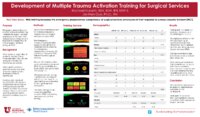 |
Development of Multiple Trauma Activation Training for Surgical Services | Hubertz, Rachael; Guo, Jia-Wen | 2023 | POSTER |
| 93 |
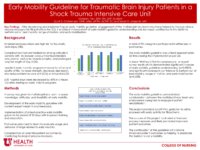 |
Early Mobility Guideline for Traumatic Brain Injury Patients in a Shock Trauma Intensive Care Unit | Park, Marleen D.; Majercik, Sarah D.; Christensen, Scott S. | 2022 | POSTER |
| 94 |
 |
Early, Systematic Palliative Care Referrals in Patients with; Metastatic Gastrointestinal Cancer | Bayer, Valkyria R.; Gee, Julia P. | 2022 | POSTER |
| 95 |
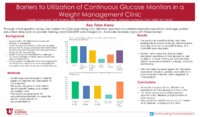 |
Exploring Barriers to the Utilization of Continuous Glucose Monitors in a Weight Management Clinic: A Needs Assessment | Shepherd, Caden | 2023 | POSTER |
| 96 |
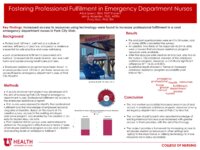 |
Fostering Professional Fulfillment in Emergency Department Nurses | Speak, Alice | 2023 | POSTER |
| 97 |
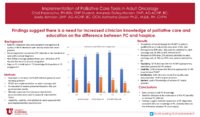 |
Implementation of Palliative Care Tools in Adult Oncology | Iheanacho, Chidiebere N. | 2023 | POSTER |
| 98 |
 |
Implementation of the VExUS Protocol: A Quality Improvement Project | Barco, Samuel; Drury, Zach; Favero, Heidi; Gee, Julie | 2023 | POSTER |
| 99 |
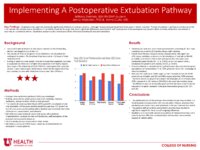 |
Implementing A Postoperative Extubation Pathway | Steinfels, Brittany; Alderden, Jenny | 2022 | POSTER |
| 100 |
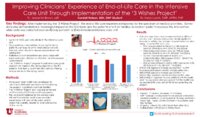 |
Improving Clinicians' Experience of End-of-Life Care in the Intensive Care Unit Through Implementation of the ‘3 Wishes Project' | Nelson, Kendall K. | 2023 | POSTER |
